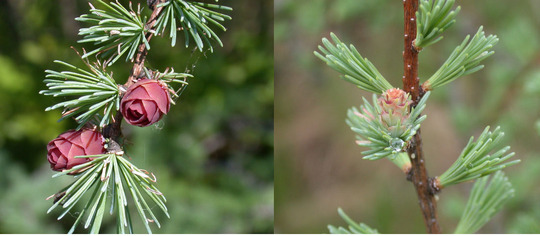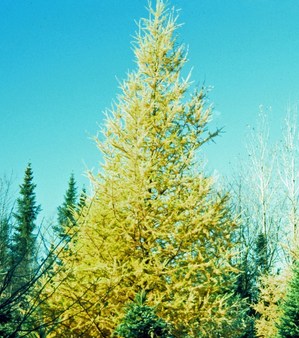Ann Arbor Native: Tamarack, the conifer that dares to be different

Closeup views of the Tamarack (Larix laricina) seed cones and its needles.
Photos by Matt Heumann
In Michigan, Tamarack trees are normally found in wet soils in swamps, bogs and along lake edges. It is a fast-growing pioneer species that may reach a height of 60 feet with an open, pyramidal form spreading to about 25 feet wide. It has thin bark and a shallow root system, so fire is not its friend. Should a decent fire roar through its habitat, the trees would likely be killed and the area would have to be re-populated by airborne seeds blown in from nearby trees that were lucky enough to be missed by the fire. So, if you want to plant one in your yard, try to avoid setting it on fire.
As a member of the pine family (Pinaceae), it has cones and needles, but the needles are much softer than your average pine tree. They are quite short (only about one inch long), form in clusters of about 10-20 off of short spur shoots around and along the tree’s stems and are bright green when they emerge in spring, turning to a golden yellow in fall. Tamaracks are monoecious (both pollen and seed cones appear on one tree) and have seed cones less than two centimeters long. Birds and small mammals get some use out of it, too, for cover, for nesting and for food, although it isn’t a major source of food for any animal, apparently.

Tamarack in the early stages of its golden fall color.
Photo by USDA Forest Service - North Central Research Station Archive, USDA Forest Service, Bugwood.org
Unlike the Eastern Redcedar we talked about last week, the Eastern Larch is much more limited in range. There are three Larix species native to North America, and 10 in the world, but only Larix Laricina is native to Michigan. It is also native in Wisconsin, Minnesota and the northern northeastern United States (plus most of Canada). For a very detailed, scientific discussion of the tree, take a look at the USDA Forest Service Fire Effects Information System (FEIS) web page on tamarack.
As it is a fairly common tree in the northeastern states (including Michigan), it is logical that it provided Native Americans with material for medicine, building materials and other uses. To see some of them, check out the University of Michigan-Dearborn Ethnobotany website.
At my place of employment, they have a section of a seven-inch wide tamarack log with a three-inch hole in the center of it. It is part of the first water system in Detroit. In the 1820s, tamarack logs were cut down in swamps near what is now Mount Clemens and floated down to Detroit. A three-inch hole was drilled in the center, and logs were joined together end to end and buried about three feet deep. It wasn’t a big system, and was replaced in the 1830s by an iron pipe system, but I thought that was pretty cool.
If you want to use tamarack for your landscape, make sure you give it a place with lots of light as it is very intolerant of shade. According to the book "Native Trees, Shrubs and Vines for Urban and Rural America" by Gary L. Hightshoe, it is resistant to salt and soil compaction, so you could put it in your front yard, for a change of pace from the average spruce people like to plant, and enjoy the fall color it provides.
I want to mention a series of seminars being put on by the Washtenaw County Conservation District for homeowners with properties of five acres or less, entitled the “ Backyard Conservation Workshop Series” which will cover a variety of subjects, including soils and soil testing, naturalized landscaping (which I’ll be speaking about), lawn and lawn care, trees and shrubs, backyard ponds, septic systems (not the same thing), composting, wildlife damage and control, backyard wildlife habitat certification and many more. Check out the WCCD's website for more information. Also, the Conservation District is now taking orders for their annual tree and native plant sale. See http://washtenawcd.org/ps/treeplantsale.php.
Get out and walk in a frozen swamp, everyone; enjoy it and see if you can find a dormant larch for yourself in the next month.
Rick is a local landscape architect with a special interest in all things natural, including native plants and the critters that eat them. You can contact him at yourland1824@gmail.com.


Comments
Rick Meader
Thu, Jan 27, 2011 : 3:48 a.m.
Thanks for your comments, everyone! I had no idea Tamarack was such a popular tree. I should have written about it long ago! Thanks for the suggestions of where people can go to see it. Another place with a really pretty stand in the fall is the west end of Pickerel Lake. Very nice. One comment in particular I wanted to respond to was Rork's. I did some heavy research (Wikipedia) and found the the larch sawfly can cause fatal epidemics for Tamarack. If you want to see what it says, here is the link (<a href="http://en.wikipedia.org/wiki/Larix_laricina)" rel='nofollow'>http://en.wikipedia.org/wiki/Larix_laricina)</a>. Thanks for reading and commenting, everyone!
Joe Wood
Wed, Jan 26, 2011 : 9:31 p.m.
My house, which was built in 1864, sits on beams made from these trees.
shrewdrealist
Wed, Jan 26, 2011 : 7:23 p.m.
Thanks for giving Larix it's proper recognition! Another deciduous conifer tree that does well in the area is Metasequoia. It's not technically a native but was thought to be extinct until botanists discovered it in Asia in the 1940's. It's automatically native anywhere in my book due to the fact that it's millions of years old. When you're driving along South Main near the Scio Church intersection you can see a some monster Metasequoias in the golf course.
Beth
Tue, Jan 25, 2011 : 6:44 p.m.
A comment about planting them in your yard - put them where they can't drop needles into your gutter or onto your car, if you park it in the driveway or road. My parents have a gorgeous larch at their house, and it was wonderful to climb it and collect its pinecones as a child, but the needles can be a real hassle to clean up.
Ben Connor Barrie
Tue, Jan 25, 2011 : 4:56 p.m.
Larix laricina is a great tree. I like that the city has used them for landscaping in the West Park renovation. There is also a great grove of them in the Arb.
PhillyCheeseSteak
Tue, Jan 25, 2011 : 4:36 p.m.
There are many beautiful old tamaracks in the University of Michigan's golf course (across from the football stadium). This golf course is a lovely place for a winter walk, with rolling hills and a nice view of Ann Arbor from the highest point.
Rork Kuick
Tue, Jan 25, 2011 : 1:32 p.m.
I think I've been witnessing allot of tamaracks dying out there in the wild. Maybe I'm wrong, but I would be curious if there are famous causes. The swamps I know around here have lower water levels since about 1995, but they still seem wet enough, so I'm not sure that's it. "I am the Larix. I speak for the trees."
Monica Milla
Tue, Jan 25, 2011 : 10:59 a.m.
Lol, I had no idea tamarack was another name for larch, but that does explain a lot! I love larches, esp. this one with its cute little pine cones.